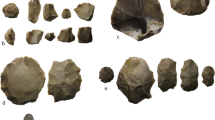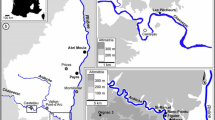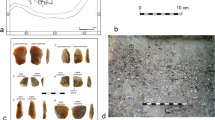Abstract
There is consensus that the modern human lineage appeared in Africa before 100,000 years ago1,2. But there is debate as to when cultural and cognitive characteristics typical of modern humans first appeared, and the role that these had in the expansion of modern humans out of Africa3. Scientists rely on symbolically specific proxies, such as artistic expression, to document the origins of complex cognition. Advanced technologies with elaborate chains of production are also proxies, as these often demand high-fidelity transmission and thus language. Some argue that advanced technologies in Africa appear and disappear and thus do not indicate complex cognition exclusive to early modern humans in Africa3,4. The origins of composite tools and advanced projectile weapons figure prominently in modern human evolution research, and the latter have been argued to have been in the exclusive possession of modern humans5,6. Here we describe a previously unrecognized advanced stone tool technology from Pinnacle Point Site 5–6 on the south coast of South Africa, originating approximately 71,000 years ago. This technology is dominated by the production of small bladelets (microliths) primarily from heat-treated stone. There is agreement that microlithic technology was used to create composite tool components as part of advanced projectile weapons7,8. Microliths were common worldwide by the mid-Holocene epoch, but have a patchy pattern of first appearance that is rarely earlier than 40,000 years ago9,10, and were thought to appear briefly between 65,000 and 60,000 years ago in South Africa and then disappear. Our research extends this record to ∼71,000 years, shows that microlithic technology originated early in South Africa, evolved over a vast time span (∼11,000 years), and was typically coupled to complex heat treatment that persisted for nearly 100,000 years. Advanced technologies in Africa were early and enduring; a small sample of excavated sites in Africa is the best explanation for any perceived ‘flickering’ pattern.
This is a preview of subscription content, access via your institution
Access options
Subscribe to this journal
Receive 51 print issues and online access
$199.00 per year
only $3.90 per issue
Buy this article
- Purchase on Springer Link
- Instant access to full article PDF
Prices may be subject to local taxes which are calculated during checkout



Similar content being viewed by others
References
Blum, M. G. B. & Jakobsson, M. Deep divergences of human gene trees and models of human origins. Mol. Biol. Evol. 28, 889–898 (2011)
Endicott, P., Hob, S. Y. W. & Stringer, C. Using genetic evidence to evaluate four palaeoanthropological hypotheses for the timing of Neanderthal and modern human origins. J. Hum. Evol. 59, 87–95 (2010)
d’Errico, F. & Stringer, C. Evolution, revolution or saltation scenario for the emergence of modern cultures? Phil. Trans. R. Soc. B 366, 1060–1069 (2011)
Powell, A., Shennan, S. & Thomas, M. Late Pleistocene demography and the appearance of modern human behavior. Science 324, 1298–1301 (2009)
Sisk, M. L. & Shea, J. J. The African origin of complex projectile technology: an analysis using tip cross-sectional area and perimeter. Int. J. Evol. Biol. 2011, 968012 (2011)
Brooks, A. S., Nevell, L., Yellen, J. E. & Hartman, G. in Transitions Before the Transition (eds Hovers, E. & Kuhn, S. L. ) 233–255 (Springer, 2006)
Clark, J. D. in Recent Advances in Indo-Pacific Prehistory (eds Misra, V. N. & Bellwood, P. ) 95–101 (E. J. Brill, 1985)
Ambrose, S. Small things remembered: origins of early microlithic industries in Sub-Saharan Africa. Archaeol. Papers Am. Anthropol. Assoc. 12, 9–29 (2002)
Kuhn, S. & Elston, R. Introduction: thinking small globally. Archaeol. Papers Am. Anthropol. Assoc. 12, 1–7 (2002)
Kuhn, S. Pioneers of microlithization: the “proto-Aurignacian” of Southern Europe. Archaeol. Papers Am. Anthropol. Assoc. 12, 83–94 (2002)
Manega, P. C. Geochronology, Geochemistry and Isotopic Study of the Plio-Pleistocene Hominid Sites and the Ngorongoro Volcanic Highland in Northern Tanzania. PhD thesis, Univ. Colorado (1993)
Skinner, A. R., Hay, R. L., Masao, F. & Blackwell, B. A. B. Dating the Naisiusiu Beds, Olduvai Gorge, by electron spin resonance. Quat. Sci. Rev. 22, 1361–1366 (2003)
Gliganic, L. A., Jacobs, Z., Roberts, R. G., Domínguez-Rodrigo, M. & Mabulla, A. Z. P. New ages for Middle and Later Stone Age deposits at Mumba rockshelter, Tanzania: optically stimulated luminescence dating of quartz and feldspar grains. J. Hum. Evol. 62, 533–547 (2012)
Barham, L. Backed tools in Middle Pleistocene central Africa and their evolutionary significance. J. Hum. Evol. 43, 585–603 (2002)
Herries, A. I. R. A chronological perspective on the Acheulian and its transition to the Middle Stone Age in Southern Africa: the question of the Fauresmith. Int. J. Evol. Biol. 2011, 1–25 (2011)
Barham, L. Clarifying some fundamental errors in Herries’ “a chronological perspective on the Acheulian and its transition to the Middle Stone Age in southern Africa: the question of the Fauresmith. Int. J. Evol. Biol. 2012, 1–5 (2012)
Jacobs, Z. et al. Ages for the Middle Stone Age of Southern Africa: implications for human behavior and dispersal. Science 322, 733–735 (2008)
Brown, K. S. et al. Fire as an engineering tool of early modern humans in coastal South Africa. Science 325, 859–862 (2009)
Singer, R. & Wymer, J. The Middle Stone Age at Klasies River Mouth in South Africa (Univ. of Chicago Press, Chicago, 1982)
Wurz, S. The Howiesons Poort backed artefacts from Klasies River: an argument for symbolic behavior. S. Afr. Archaeol. Bul. 54, 38–50 (1999)
Adams, D. C. et al. Geometric morphometrics: ten years of progress following the ‘revolution’. Ital. J. Zool. (Modena) 71, 5–16 (2004)
Rohlf, F. J. tpsDig Version 2.10. http://life.bio.sunysb.edu/morph/index.html (2006)
Mellars, P. Major issues in the emergence of modern humans. Curr. Anthropol. 30, 349–385 (1989)
Bar-Yosef, O. & Kuhn, S. The big deal about blades: laminar technologies and human evolution. Am. Anthropol. 101, 322–338 (1999)
Clark, J. D., Phillips, J. & Staley, P. S. Interpretations of prehistoric technology from ancient Egyptian and other sources. Part I: ancient Egyptian bows and arrows and their relevance for African prehistory. Paleorient 2, 323–388 (1974)
Clark, J. D. Interpretations of prehistoric technology from ancient Egyptian and other sources. Part II: prehistoric arrow forms in Africa as shown by surviving examples of traditional arrows of the San Bushmen. Paleorient 3, 127–150 (1975)
Pétillon, J.-M. et al. Hard core and cutting edge: experimental manufacture and use of Magdalenian composite projectile tips. J. Archaeol. Sci. 38, 1266–1283 (2011)
Shea, J. The origins of lithic projectile point technology: evidence from Africa, the Levant, and Europe. J. Archaeol. Sci. 33, 823–846 (2006)
Bingham, P. M. Human evolution and human history: A complete theory. Evol. Anthropol. 9, 248–257 (2000)
Churchill, S. E., Franciscus, R., McKean-Peraza, H., Daniel, J. & Warren, B. Shanidar 3 Neandertal rib puncture wound and paleolithic weaponry. J. Hum. Evol. 57, 163–178 (2009)
Marean, C. W. et al. Paleoanthropological investigations of Middle Stone Age sites at Pinnacle Point, Mossel Bay (South Africa): Archaeology and hominid remains from the 2000 Field Season. PaleoAnthropol. 83, 14–83 (2004)
Dibble, H. L. et al. The use of barcodes in excavation projects. SAA Archaeol. Rec. 7, 33–38 (2005)
Marean, C. W. et al. The stratigraphy of the Middle Stone Age sediments at Pinnacle Point Cave 13B (Mossel Bay, Western Cape Province, South Africa). J. Hum. Evol. 59, 234–255 (2010)
Bernatchez, J. & Marean, C. W. Total station archaeology and the use of digital photography. SAA Archaeol. Rec. 11, 16–21 (2011)
Huntley, D. J., Godfrey-Smith, D. I. & Thewalt, M. L. W. Optical dating of sediments. Nature 313, 105–107 (1985)
Aitken, M. J. An Introduction to Optical Dating (Oxford Univ. Press, 1998)
Duller, G. A. T. Luminescence dating of Quaternary sediment: recent developments. J. Quat. Sci. 19, 183–192 (2004)
Lian, O. B. & Roberts, R. G. Dating the Quaternary: progress in luminescence dating of sediments. Quat. Sci. Rev. 25, 2449–2468 (2006)
Jacobs, Z. & Roberts, R. G. Advances in optically stimulated luminescence dating of individual grains of quartz from archeological deposits. Evol. Anthropol. 16, 210–223 (2007)
Wintle, A. G. Fifty years of luminescence dating. Archaeometry 50, 276–312 (2008)
Bookstein, F. L. Landmark methods for forms without landmarks: morphometrics of group differences in outline shape. Med. Image Anal. 1, 225–243 (1997)
Acknowledgements
We thank the MAPCRM staff for their assistance, the Dias Museum for field facilities, and SAHRA and HWC for permits. This research was funded by the National Science Foundation (grants BCS-9912465, BCS-0130713, BCS-0524087 and BCS-1138073 to C.W.M.), the Hyde Family Foundation, the Institute of Human Origins (IHO), and the Australian Research Council (DP1092843 to Z.J.).
Author information
Authors and Affiliations
Contributions
K.S.B. led the lithic analysis and with C.W.M. took the lead in writing the paper; J.B. contributed to the site analysis; E.C.F. conducted the GIS analysis and photomosaic construction; C.W.M. is the project director and an excavation permit co-holder; S.O. contributed to the lithic analysis; B.J.S. contributed to the lithic analysis and conducted the morphometric analysis; Z.J. conducted the OSL dating; P.K. studied the sedimentology and geology of the site; T.M. is an excavation permit co-holder and contributes to palaeoenvironmental studies; and J.B., K.S.B., E.C.F., C.W.M., S.O. and B.J.S. all contributed substantially to the excavations. All authors contributed to the writing of the paper.
Corresponding author
Ethics declarations
Competing interests
The authors declare no competing financial interests.
Additional information
The data reported in this paper are tabulated in the Supplementary Information and archived at Arizona State University.
Supplementary information
Supplementary Information
This file contains Supplementary Discussions, Supplementary Methods, Supplementary Figures 1-10, Supplementary Tables 1-7 and additional references. (PDF 1935 kb)
Rights and permissions
About this article
Cite this article
Brown, K., Marean, C., Jacobs, Z. et al. An early and enduring advanced technology originating 71,000 years ago in South Africa. Nature 491, 590–593 (2012). https://doi.org/10.1038/nature11660
Received:
Accepted:
Published:
Issue Date:
DOI: https://doi.org/10.1038/nature11660
This article is cited by
-
Terminal ballistic analysis of impact fractures reveals the use of spearthrower 31 ky ago at Maisières-Canal, Belgium
Scientific Reports (2023)
-
From Hafting to Retooling: Miniaturization as Tolerance Control in Paleolithic and Neolithic Blade Production
Journal of Archaeological Method and Theory (2023)
-
A Predictive Model for the Non-Destructive Assessment of Stone Age Silcrete Heat Treatment Strategies
Journal of Paleolithic Archaeology (2023)
-
Miniaturization and Abstraction in the Later Stone Age
Biological Theory (2023)
-
Cultural Developments Between the Final MSA and the Robberg at Umbeli Belli, KwaZulu-Natal, South Africa
Journal of Paleolithic Archaeology (2023)
Comments
By submitting a comment you agree to abide by our Terms and Community Guidelines. If you find something abusive or that does not comply with our terms or guidelines please flag it as inappropriate.



